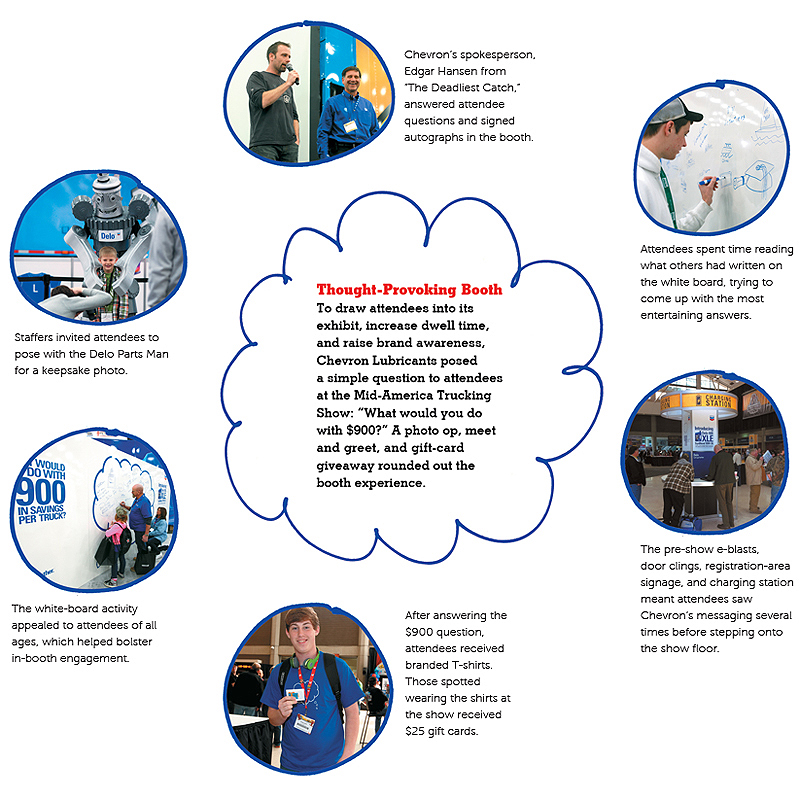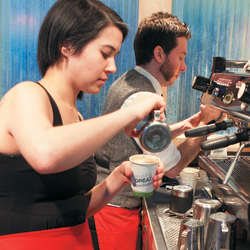| ALL STAR |
 Carrie Jewkes began her career with Chevron Lubricants in 2003, working in various roles for all market segments. She now manages Chevron's brand presence at trade shows and events across the country as the events coordinator. Carrie Jewkes began her career with Chevron Lubricants in 2003, working in various roles for all market segments. She now manages Chevron's brand presence at trade shows and events across the country as the events coordinator.

 Angi Schoolcraft has been the event marketing specialist for Chevron Lubricants since February 2013. She has worked at Chevron for more than 10 years in myriad positions, and currently manages all national trade shows for the division. Angi Schoolcraft has been the event marketing specialist for Chevron Lubricants since February 2013. She has worked at Chevron for more than 10 years in myriad positions, and currently manages all national trade shows for the division. |

f you want to get attention at a bustling event like the Mid-America Trucking Show, you had better have something valuable to say. As the U.S. trucking industry's largest trade show, MATS draws a wide swath of big-name exhibitors such as Peterbilt Motors Co., Mack Trucks Inc., and Goodyear Tire and Rubber Co., to name a few, and they all compete for face time with the 78,000 fleet owners, truck drivers, mechanics, manufacturers, and owner/operators walking the trade show floor. What's more, companies within the trucking industry are particularly good at cultivating die-hard fans, making it hard for exhibitors to persuade prospects and customers to spend time with the so-called other guys.
So what, exactly, is one to do to pull attention away from the competition? This was the challenge facing Chevron Lubricants, a division of Chevron U.S.A. Inc., leading up to the 2013 show. In the past, the company had focused on lead generation and sales, like most exhibitors on the show floor. And though little was done by way of in-booth engagement and promotion in the exhibit hall, Chevron had considered its nuts-and-bolts approach to exhibiting successful. Attendees would stroll by the booth, and those interested in learning more would enter. But for 2013, the company wanted to zero in on brand awareness and product promotion for its newest lubricant, Delo 400 XLE Synblend 10W-30. Specifically, it sought to convey that Delo can save truckers an average of $900 per truck, per year, thanks to its ability to increase fuel economy. Chevron figured that $900 in savings would be enough to get people to listen; it just had to determine the best way to communicate the marketing message to the masses.
That task fell to Chevron's marketing specialist for events at the time, Carrie Jewkes, and its current marketing specialist for events, Angi Schoolcraft. "We knew we needed to cover every square inch of MATS with brand and product messaging if we had any hope of cutting through the distractions and reaching attendees," Jewkes says. "And that meant getting the rest of the marketing team's buy in." That's because a shift in strategy meant a change in how the budget was allocated – including pulling money from other shows on Chevron's calendar to make it happen. So Jewkes got to work greasing the wheels. "It took a little bit of convincing, but we made a solid case for what we wanted and soon everyone got on board," she says. With the additional funds, Jewkes purchased prime exhibit space and sponsorships in highly visible areas of the convention center, including the entrances and lobby.
The all-over messaging would be bolstered, Jewkes and Schoolcraft surmised, with an in-booth activity that could be used to reinforce the $900 savings. "We wanted to do something to capture everyone's attention," Schoolcraft says. They just didn't yet know what that activity would be.
Switching Gears
With the objectives and money secured thanks to Jewkes, Schoolcraft met with Chevron's exhibit house, Louisville, KY-based Deckel & Moneypenny Exhibits, to devise a plan for mass-message dissemination and booth activities. During one of those meetings, Schoolcraft shared the Delo key message – that it can generate $900 in savings per truck, per year – with Steve Deckel, design director
at Deckel & Moneypenny. The pair started thinking about what they would do if they had an extra $900 to spend, and that got them thinking. "Initially, Chevron wanted to feature photos of different items around a $900 price point in the booth, but there's nothing interactive or engaging about that concept," Deckel says. "We decided to find out what the target audience would do with $900, so we asked them in an informal poll. Not surprisingly, their answers were all over the board."
And then genius struck. What if, instead of telling people all the things they could buy with $900, Chevron asked attendees to do the talking? "This idea blossomed into an engaging concept where we'd invite attendees to draw or write the things they'd buy with an extra $900," Deckel says. To make it even more dynamic, Deckel wanted to use a staple of classrooms and meeting rooms the world over: the white board. "I had never seen anything like that at MATS, but I had seen something similar at EXHIBITOR Show, where attendees ate it up," he says. The concept also struck a chord with All-Star Awards judges, one of whom said, "White boards are a great engagement hook that pulls people in to the experience."
Schoolcraft and Jewkes loved the idea because it presented an opportunity to do something few MATS exhibitors achieve: make an emotional connection with attendees. "MATS is a public show, and attendees bring their families," Jewkes says. "Having an activity broadened our appeal." To encourage that participation and get people to visit Chevron at the show, Schoolcraft worked with Deckel to develop pre-show e-blasts that introduced Delo and invited attendees to the booth to meet Chevron's longtime spokesperson, fisherman Edgar Hansen from "The Deadliest Catch."
The pre-show communication also debuted what would become a central visual throughout the campaign – an easily recognizable blue-and-white color scheme. "Most of the exhibits at MATS are aesthetically busy with a lot going on, so we wanted to keep it simple with a palette that would be repeated throughout the booth," Deckel says. Those two colors were found on branded giveaways such as baseball caps and T-shirts, signage that would appear throughout the convention center, and the exhibit walls.
Talk to Me
When attendees arrived at the convention center on March 27, they were greeted by door clings on the venue's north and south entrances featuring Delo and Chevron logos, the firm's booth number, a thought-bubble outline, and the question, "What would you do with $900 in savings per truck?" That messaging was reinforced in the lobby, where attendees spotted a 6-by-15-foot banner hanging over the registration area that read, "Introducing Delo 400 XLE Synblend 10W-30," as well as a 10-foot-tall branded charging station that included the now ubiquitous $900 question and thought bubble.
Between the pre-show e-blasts, door clings, registration-area signage, and charging station, attendees had been  exposed to Chevron's messaging at least seven times before they even stepped foot in the exhibit hall. That early exposure was crucial to the success of Jewkes and Schoolcraft's marketing modus operandi. Had they waited to hit up attendees until they got inside the show floor, they'd be competing with what Deckel describes as chromed-out big rigs and booth babes in ball gowns.
exposed to Chevron's messaging at least seven times before they even stepped foot in the exhibit hall. That early exposure was crucial to the success of Jewkes and Schoolcraft's marketing modus operandi. Had they waited to hit up attendees until they got inside the show floor, they'd be competing with what Deckel describes as chromed-out big rigs and booth babes in ball gowns.
Fortunately, the $900 messaging enticed attendees to trek past the trucks and tatas to Chevron's booth where staffers greeted them. After a few short qualifying questions and a Delo spiel from staffers, attendees got the chance to answer the question, "What would you do with $900 in savings per truck?" Armed with blue dry-erase markers and a veritable blank slate, they scribbled their responses, and also spent time reading what others had written, trying to best one another's drawings and responses. This provided staffers with ample time to create the emotional brand connection Chevron sought, a fact that impressed judges. "I love the way they connected people to their product in such a personal, memorable way," one judge said.
After attendees had scribed their nuggets of financial wisdom, which ranged from "Go to Mexico again" to "Buy gold teeth," staffers invited them to pose for a keepsake photo with the Delo Parts Man mascot and to meet Edgar Hansen. Booth staffers also handed attendees branded T-shirts featuring the thought bubble on the front. To give the message some legs, Chevron "spotters" awarded people on the show floor wearing the shirts with $25 Wal-Mart gift cards, creating yet another crucial touchpoint.
The Writing's on the Wall
By the time the last $900 thought was articulated, Jewkes and Schoolcraft had achieved a staggering 1,218,140 impressions as a result of the pre- and at-show messaging, right on par with projections despite a 3.3-percent decrease in MATS' attendance compared to 2012. The thought-bubble activity also did its part to increase the length of time people spent in the booth, with the average visit exceeding Chevron's goal by 33 percent and lasting nearly twice as long as visits the previous year.
The thought bubbles helped Jewkes and Schoolcraft surpass another goal: activity engagement. While hoping for 1,000 participants, the $900 question proved irresistible to 1,682 attendees. Qualified leads that opted in for a discussion about Delo topped out at 238, exceeding pre-show goals by 19 percent, and the number of attendees that participated in other in-booth activities, such as the photo op with the Delo Parts Man and the meet and greet with Edgar Hansen, totaled 609 – 44 percent more than in 2012.
Exceeding expectations across the board is something most exhibit managers hope for, but few achieve. Hitting numbers this high is the stuff of marketing dreams – and All-Star Awards legend. Maybe the old adage is true: Ask and you shall receive. 






 f you want to get attention at a bustling event like the Mid-America Trucking Show, you had better have something valuable to say. As the U.S. trucking industry's largest trade show, MATS draws a wide swath of big-name exhibitors such as Peterbilt Motors Co., Mack Trucks Inc., and Goodyear Tire and Rubber Co., to name a few, and they all compete for face time with the 78,000 fleet owners, truck drivers, mechanics, manufacturers, and owner/operators walking the trade show floor. What's more, companies within the trucking industry are particularly good at cultivating die-hard fans, making it hard for exhibitors to persuade prospects and customers to spend time with the so-called other guys.
f you want to get attention at a bustling event like the Mid-America Trucking Show, you had better have something valuable to say. As the U.S. trucking industry's largest trade show, MATS draws a wide swath of big-name exhibitors such as Peterbilt Motors Co., Mack Trucks Inc., and Goodyear Tire and Rubber Co., to name a few, and they all compete for face time with the 78,000 fleet owners, truck drivers, mechanics, manufacturers, and owner/operators walking the trade show floor. What's more, companies within the trucking industry are particularly good at cultivating die-hard fans, making it hard for exhibitors to persuade prospects and customers to spend time with the so-called other guys. 




